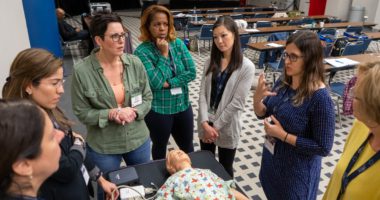Last week, an expert panel from the National Asthma Education and Prevention Program Coordinating Committee released its 2020 Focused Updates to the Asthma Management Guidelines. Although not a complete revision of EPR-3, which was last updated in 2007, this document updates selected topics that were identified as a high priority by a National Heart, Blood and Lung Institute (NHLBI) Advisory Council Asthma Expert Working Group.

These six priority topics included:
- Fractional exhaled nitric oxide (FeNO) in diagnosis, medication selection, and monitoring of treatment response in asthma.
- Remediation of indoor allergens (e.g., house-dust mites/pets) in asthma management.
- Adjustable medication dosing in recurrent wheezing and asthma.
- Long-acting antimuscarinic agents (LAMAs) in asthma management as add-ons to inhaled corticosteroids (ICSs).
- Immunotherapy and the management of asthma.
- Bronchial thermoplasty (BT) in adult severe asthma.
Of the above topics, fractional exhaled nitric oxide, long-acting muscarinic antagonists, and bronchial thermoplasty were not addressed in EPR-3. Below is a summary of new recommendations for the three previously mentioned topics, as well as key changes from the 2007 guidelines regarding allergen mitigation, inhaled corticosteroid use, and immunotherapy in the management of asthma.
Please note many of these recommendations related to medication usage are not approved by the FDA. Biologics for asthma were not addressed in this focused guideline. Please post comments for discussion of the new NHLBI Updates to DocMatter.
Fractional exhaled nitric oxide
- There are conditional recommendations for using FeNO:
- In individuals aged 5 years and older for whom the diagnosis of asthma is uncertain using history, clinical findings, clinical course, and spirometry, including bronchodilator responsiveness testing, or in whom spirometry cannot be performed, the Expert Panel conditionally recommends the addition of FeNO measurement as an adjunct to the evaluation process
- In individuals aged 5 years and older with persistent allergic asthma, for whom there is uncertainty in choosing, monitoring, or adjusting anti-inflammatory therapies based on history, clinical findings, and spirometry, the Expert Panel conditionally recommends the addition of FeNO measurement as part of an ongoing asthma monitoring and management strategy that includes frequent assessments
- The panel gives a strong recommendation against using FeNO in individuals 5 years and older in isolation to assess asthma control, predict future exacerbations, or assess exacerbation severity.
- The panel also gives a strong recommendation against using FeNO in children 0 – 4 years old with recurrent wheezing to predict the future development of asthma
Allergen Mitigation
There were some changes from the 2007 guidelines in a few key recommendations:
- This recommendation was a departure from the 2007 guideline. It gives a conditional recommendation against allergen mitigation interventions as part of routine asthma management in individuals with asthma who do not have sensitization to specific indoor allergens or who do not have symptoms related to exposure to specific indoor allergens. This varied from the 2007 recommendation that stated patients with any level of asthma severity should reduce their exposure to allergens to which they are sensitized and exposed, regardless of symptoms related to that exposure.
- A multicomponent allergen-specific mitigation intervention in those with asthma who are exposed and have symptoms related to identified indoor allergens, confirmed by history taking or allergy testing. This clarified a 2007 statement that applied similar recommendations to all asthmatics.
- Expands on the cockroach control recommendations from 2007 by giving a conditional recommendation for using integrated pest management alone or as part of a multicomponent allergen-specific mitigation intervention in those individuals with asthma who are exposed and have sensitization or symptoms related to exposure to pests (cockroaches and rodents).
- Dust mite control measures should not be used as a single component intervention, but rather as part of a multicomponent allergen mitigation intervention. It also does not mention washing sheets and blankets in hot water weekly, rather highlighting only impermeable pillow/mattress covers as an intervention.
ICS
Some of the biggest departures from the 2007 guidelines come in this section, moving more in line with what was seen in the recent Global Initiative for Asthma (GINA) guideline update. As part of these revisions, the guideline released three updated “step” tables highlighting the new preferred and alternative treatments for asthmatics based on age (0-4, 5-11, 12 and up) and “step” (1-6). The notable differences are listed below:
- This recommendation was a change from the 2007 one. Rather than recommending Short-acting beta antagonists (SABAs) every 4-6 hours for mild exacerbations and a short course of oral systemic steroids for moderate to severe exacerbations in children 0-4 years old, a conditional recommendation is given for starting a short course of daily Inhaled corticosteroids (ICS) at the onset of a respiratory tract infection with PRN SABA for quick relief therapy in children 0-4 years with recurrent wheezing triggered by respiratory tract infections and no wheezing between infections. This is now Step 1 on the revised 0-4 step table.
- The recommendation for daily low dose ICS + PRN SABA for mild persistent asthmatics 12 years or older to a conditional recommendation for either daily low dose ICS + PRN SABA or ICS/SABA used concomitantly PRN. This change is reflected in Step 2 of the updated step table for 12 years and older.
- A conditional recommendation that specifically advises against a temporary increase in ICS dose for increased symptoms or decreased peak flow in those 4 years and older with mild to moderate asthma who are on daily ICS treatment.
- A change from 2007 guidelines isgiving a strong recommendation for ICS-formoterol in a single inhaler to be used both as daily controller and reliever therapy compared to either higher-dose ICS as a daily controller + SABA for quick relief or same-dose ICS- long-acting beta antagonist (LABA) as daily controller + SABA for quick relief in those 4 years and older with moderate to severe persistent asthma. This covers both Step 3 (low dose ICS) and Step 4 (medium dose ICS).
- a conditional recommendation of ICS-formoterol in a single inhaler to be used as both daily controller and reliever therapy compared to higher dose ICS-LABA as daily controller therapy and SABA for quick relief in those 12 and older with moderate to severe persistent asthma (Step 4).
LAMA
Three new conditional recommendations are given regarding LAMAs:
- In individuals aged 12 years and older with uncontrolled persistent asthma, the Expert Panel conditionally recommends against adding LAMA to ICS compared to adding LABA to ICS.
- If LABA is not used in individuals aged 12 years and older with uncontrolled persistent asthma, the Expert Panel conditionally recommends adding LAMA to ICS controller therapy compared to continuing the same dose of ICS alone.
- In individuals aged 12 years and older with uncontrolled persistent asthma, the Expert Panel conditionally recommends adding LAMA to ICS-LABA compared to continuing the same dose of ICS-LABA.
Immunotherapy
Rather than a combined recommendation to consider allergen immunotherapy (AIT) for persistent asthma in the presence of symptoms and sensitization, the updated 2020 guidelines suggest the following:
- Conditional recommendation for use of subcutaneous immunotherapy (SCIT) as an adjunct treatment to standard pharmacotherapy in individuals ages 5 years and older with mild to moderate allergic asthma whose asthma is under control at the initiation, build-up, and maintenance phases of immunotherapy
- Conditional recommendation against use of sublingual immunotherapy (SLIT) for asthma treatment in individuals with persistent allergic asthma.
Bronchial Thermoplasty
In individuals 18 years and older with persistent asthma, the Expert Panel conditionally recommends against BT. However, they do state that in those 18 years and older with persistent asthma who place a low value on harms (short-term worsening symptoms and unknown long-term side effects) and a high value on potential benefits (improvement in quality of life, a small reduction in exacerbation) might consider BT.
In addition to the above recommendations, one of the biggest changes in the 2020 update is the addition of an Implementation Guidance section for each recommendation. This guidance section begins with clinician summary and then goes on to provide clarification of the population to which each recommendation applies, exceptions to the recommendation, and practical aspects to show to use recommendation in patient care. It concludes with a list of issues suggested by the Expert Panel to communicate with patients as part of shared decision-making about whether to use therapy or intervention.
This update also includes amended step diagrams as previously mentioned, with many of the updated interventions now being preferred first line treatments.
We highly recommend you read “2020 Focused Updates to the Asthma Management Guidelines: A Report from the National Asthma Education and Prevention Program Coordinating Committee Expert Panel Working Group.”



